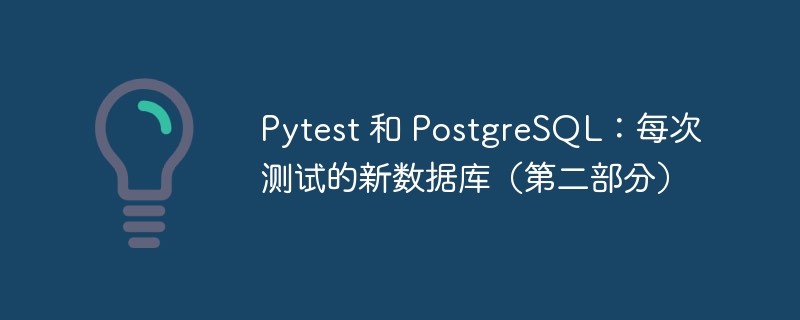Pytest 和 PostgreSQL:每次测试的新数据库(第二部分)

在上一篇文章中,我们创建了 pytest 夹具,它将在测试方法之前/之后创建/删除 postgres 数据库。在这一部分中,我想在 pytest 工厂固定装置的帮助下改进固定装置,使其更加灵活和可配置。
静态夹具的限制
例如,如果您有多个数据库要在测试中模拟
def test_create_user(test_db1, test_db2):
...
您必须创建几乎两个相同的灯具:
test_db_url = "postgresql://localhost"
test_db1_name = "test_foo"
test_db2_name = "test_bar"
@pytest.fixture
def test_db1():
with psycopg.connect(test_db_url, autocommit=true) as conn:
cur = conn.cursor()
cur.execute(f'drop database if exists "{test_db1_name}" with (force)')
cur.execute(f'create database "{test_db1_name}"')
with psycopg.connect(test_db_url, dbname=test_db1_name) as conn:
yield conn
cur.execute(f'drop database if exists "{test_db1_name}" with (force)')
@pytest.fixture
def test_db2():
with psycopg.connect(test_db_url, autocommit=true) as conn:
cur = conn.cursor()
cur.execute(f'drop database if exists "{test_db2_name}" with (force)')
cur.execute(f'create database "{test_db2_name}"')
with psycopg.connect(test_db_url, dbname=test_db2_name) as conn:
yield conn
cur.execute(f'drop database if exists "{test_db2_name}" with (force)')
pytest 夹具工厂
“静态”装置在这里有点限制。当需要几乎相同且仅有细微差别时,您需要复制代码。希望 pytest 有工厂作为固定装置的概念。
工厂固定装置是一个返回另一个固定装置的固定装置。因为,像每个工厂一样,它是一个函数,它可以接受参数来自定义返回的固定装置。按照惯例,您可以在它们前面加上 make_* 前缀,例如 make_test_db。
专用夹具
我们的装置工厂 make_test_db 的唯一参数将是要创建/删除的测试数据库名称。
那么,让我们基于 make_test_db 工厂装置创建两个“专用”装置。
用法如下:
@pytest.fixture
def test_db_foo(make_test_db):
yield from make_test_db("test_foo")
@pytest.fixture
def test_db_bar(make_test_db):
yield from make_test_db("test_bar")
旁注:产量来自
你注意到产量了吗? yield 和 yield 之间的一个关键区别在于它们如何处理生成器内的数据流和控制。
在python中,yield和yield from都在生成器函数中使用来生成一系列值,但是
- yield 用于暂停生成器函数的执行并向调用者返回单个值。
- 而yield from用于将值的生成委托给另一个生成器。它本质上“展平”了嵌套生成器,将其生成的值直接传递给外部生成器的调用者。
也就是说,我们不想从专门的夹具“屈服”,而是从夹具工厂“屈服”。因此这里需要yield from。
用于创建/删除数据库的夹具工厂
除了将代码包装到内部函数之外,对我们原始夹具创建/删除数据库所需的更改实际上几乎不需要任何更改。
@pytest.fixture
def make_test_db():
def _(test_db_name: str):
with psycopg.connect(test_db_url, autocommit=true) as conn:
cur = conn.cursor()
cur.execute(f'drop database if exists "{test_db_name}" with (force)') # type: ignore
cur.execute(f'create database "{test_db_name}"') # type: ignore
with psycopg.connect(test_db_url, dbname=test_db_name) as conn:
yield conn
cur.execute(f'drop database if exists "{test_db_name}" with (force)') # type: ignore
yield _
奖励:将迁移固定装置重写为工厂固定装置
在上一部分中,我还有一个固定装置,将 yoyo 迁移应用于刚刚创建的空数据库。它也不是很灵活。让我们做同样的事情并将实际代码包装到内部函数中。
在这种情况下,因为代码不需要在从测试方法返回后进行清理(其中没有yield),所以
- 工厂装置返回(不是yield)内部函数
- 专门的夹具调用(不是从工厂夹具中产生)
@pytest.fixture
def make_yoyo():
"""applies yoyo migrations to test db."""
def _(test_db_name: str, migrations_dir: str):
url = (
urlparse(test_db_url)
.
_replace(scheme="postgresql+psycopg")
.
_replace(path=test_db_name)
.geturl()
)
backend = get_backend(url)
migrations = read_migrations(migrations_dir)
if len(migrations) == 0:
raise valueerror(f"no yoyo migrations found in '{migrations_dir}'")
with backend.lock():
backend.apply_migrations(backend.to_apply(migrations))
return _
@pytest.fixture
def yoyo_foo(make_yoyo):
migrations_dir = str(path(__file__, "../../foo/migrations").resolve())
make_yoyo("test_foo", migrations_dir)
@pytest.fixture
def yoyo_bar(make_yoyo):
migrations_dir = str(path(__file__, "../../bar/migrations").resolve())
make_yoyo("test_bar", migrations_dir)
需要两个数据库并对它们应用迁移的测试方法:
from psycopg import Connection
def test_get_new_users_since_last_run(
test_db_foo: Connection,
test_db_bar: Connection,
yoyo_foo,
yoyo_bar):
test_db_foo.execute("...")
...
结论
构建自己的夹具工厂,为 pytest 方法创建和删除数据库实际上是练习 python 生成器和运算符的产量/产量的一个很好的练习。
我希望本文对您自己的数据库测试套件有所帮助。请随时在评论中留下您的问题,祝您编码愉快!
以上就是Pytest 和 PostgreSQL:每次测试的新数据库(第二部分)的详细内容,更多请关注其它相关文章!
